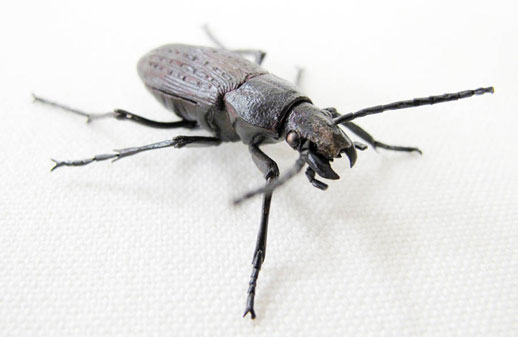In the Realm of the Living
There are no pictures on the wall, or even any visible installation of which to speak. Instead, what I can see as I approach the loft-like exhibition space at Radi-um is a cluster of men crouching in a circle on the floor. In order to get a look at the “Jizai” exhibition, I too must take off my shoes and crawl onto the tatami platform (supported, I overhear, on a collection of beer crates). There I can see artist Haruo Mitsuta’s work — a series of true to life beetles rendered in precious and semi-precious metals, displayed on individual sheets of washi paper. Each one requires a sort of meditative contemplation, which in turn reveals a maniac-like attention to detail, as well as, more generally-speaking, a sense of marvel at what the human hand and an extraordinary amount of patience can produce.
“Jizai Okimono” is, in fact, a Japanese craft that dates back to the late Edo period. Oddly enough, explained Radi-um owner Tsutomu Ikeuchi, these figures of insects and animals were then created predominantly as souvenirs for visiting foreign dignitaries. As a result, most examples are held in private collections abroad and the craft itself is little known in Japan.
Mitsuta, who earned an MFA in metal carving at Tokyo University of the Arts, admits to having had a fondness for bugs since his childhood. As a student, upon encountering a Jizai work in a museum he felt a sadness that the craft had all but vanished and thought “it would be nice if someone were still making these…” And that somebody turned out to be Mitsuta. Each work, which contains around 70 individual parts, takes him about a month to complete. Though his craftsmanship is essentially based on the original tradition (learned from a master in Kyoto), in his quest to make increasingly realistic creations, Mitsuta experiments with different metal finishes and techniques that conspire to make his work contemporary. And yes, he does use real bugs as his models, some of which he finds himself and others which are “presents” from friends.

This is Mitsuta’s first solo exhibition at an art gallery and his second appearance at Radi-um, having participated in the gallery’s group show “Moeglichkeit II” last year. According to Ikeuchi, the half-dozen or so works displayed at the latter sold out completely on the first night. It goes with out saying that it made sense to invite him back.
It was the opening night and while regular visitors passed through, Ikeuchi noted that those who lingered — and made purchases — were not his usual customers. After an article on Mitsuta ran in Art Collector magazine last year, the gallery began receiving phone calls from interested collectors. “They sought us out,” Ikeuchi said, explaining this unusual reversal of fortune which stands in contrast to the long tradition of galleries cultivating relationships with potential buyers.
It is impossible to view works such as Mitsuta’s without contemplating the fragile line drawn between art and craft. When I asked Ikeuchi how collectors might display such works, he picked one up and, holding it in his palm, explained that they wouldn’t necessarily be displayed at all. Rather than ending up in glass cases (as real bugs might), the life-sized Jizai would likely sit on desks or bookshelves, be picked up and moved around. That is to say, they would exist in the realm of the living (as opposed to becoming part of a space), thus revealing a degree of potential intimacy — between work and collector — that is undeniably part of their attraction.
Rebecca Milner
Rebecca Milner



